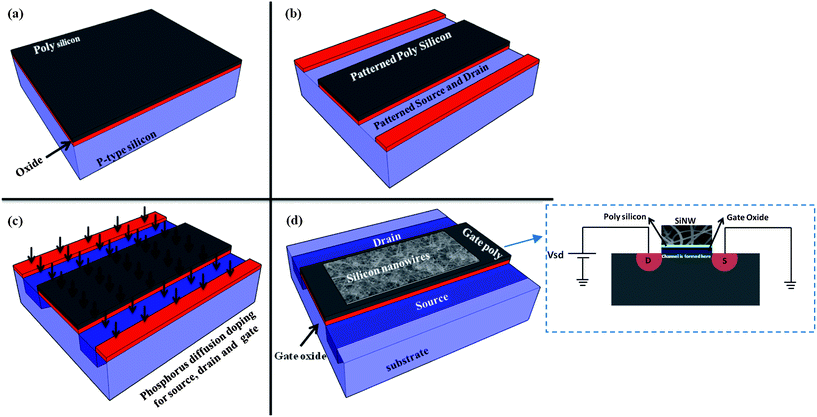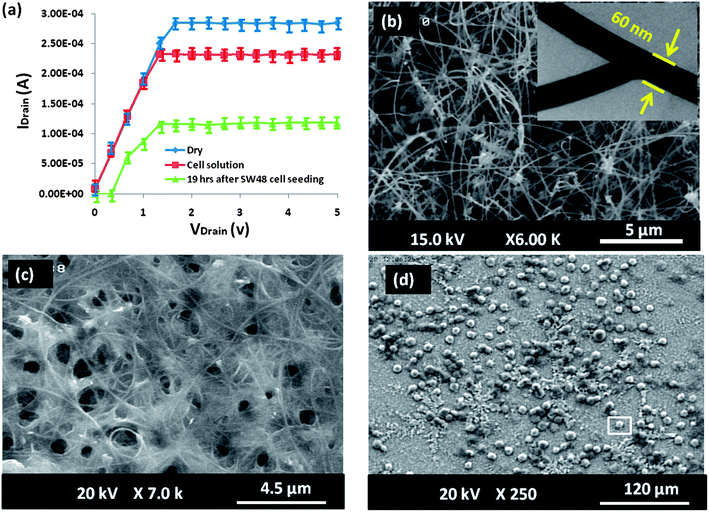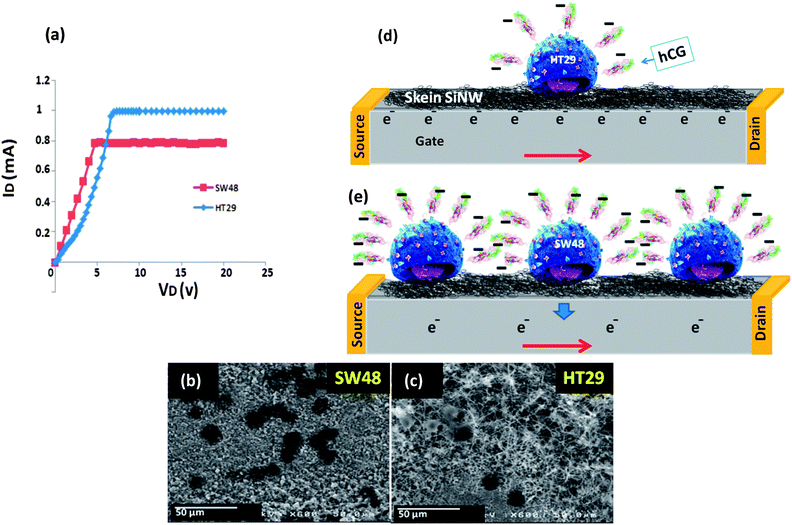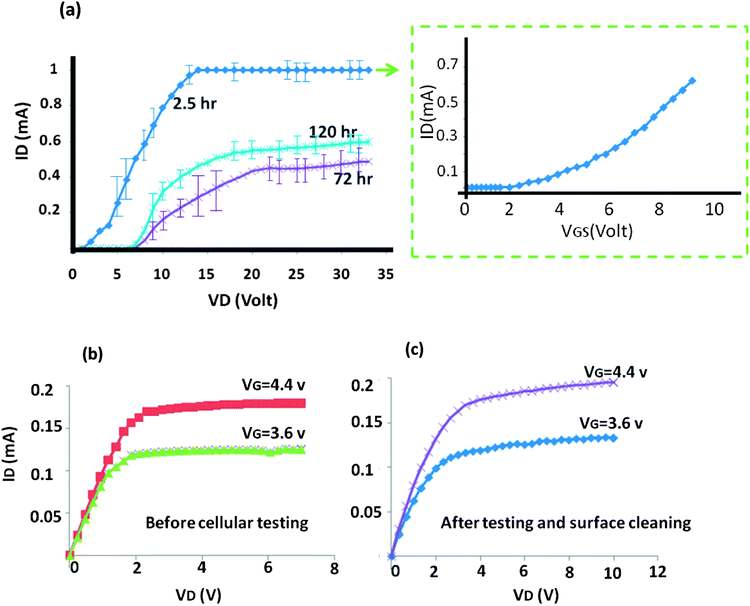Cell membrane electrical charge investigations by silicon nanowires incorporated field effect transistor (SiNWFET) suitable in cancer research†
M. Abdolahad‡
*a,
H. Taghinejad‡a,
A. Saeidi‡a,
M. Taghinejad‡a,
M. Janmaleki‡b and
S. Mohajerzadeh*a
aNano Electronic Center of Excellence, Thin Film and Nanoelectronic Lab, School of Electrical and Computer Engineering, University of Tehran, P.O. Box 14395/515, Tehran, Iran. E-mail: mohajer@ut.ac.ir; m.abdolahad@ut.ac.ir
bMedical Nanotechnology and Tissue Engineering Research Center, Shahid-Beheshti University of Medical Science, P.O. Box 1985717443, Tehran, Iran
First published on 22nd November 2013
Abstract
Obtaining biocompatible skein shaped silicon nanowires covered field-effect transistors (SiNWFETs) is reported. Such structures are formed by the growth of Si nanowires on top of the polysilicon gate terminal of a n-MOSFET in three-probe top-gate geometry for cells membrane electrical charge detection suitable in biological applications such as cancer investigations. We observe that electro-negativity increment of metastatic cells outer membrane restricts the drain current of bioFET. SiNWFET is proposed to be used covered with skein SiNW. Different invasive grades of colon cancers (HT29 and SW48) owing to their dissimilar negative charge production, affect the electrical response of the device.
1. Introduction
An electrochemical biosensor, defined by IUPAC, is a self-contained integrated device that allows for specific analytical detection by using a biological recognition element (a biochemical receptor) in direct spatial contact with a transduction element.1,2 It is still a challenge to convert the biological information into an electronic signal due to severe difficulties of connecting an electronic device to biological environment. In addition, the biochemical receptors as intermediate elements for immobilizing biological agent on the devices have many limitations in synthesis and operation. Therefore, investigation of various materials and methods to construct an electronic biosensor has been underway for decades.Nanomaterials, such as nanoparticles, nanowires and nanotubes,3–8 have been studied extensively due to their suitable properties in interaction with biological analytes as nanoscale biosensors. Because of the ultra-small size of nanomaterials, they provide a perfect feature to study biological entities such as proteins, viruses and cells.9–11 Among various nanomaterials applied in biosensing processes, silicon nanowires (SiNWs) have found a wide range of applications in the field of bioelectronics and bio-optics, owing to their unique chemical and physical properties as well as electronic device fabrication compatibilities.12–14 Si-nanowires can be considered as suitable biomaterials and possess advantages over other inorganic materials such as polycrystalline metals. Nagesha et al.15 have shown that the surface of silicon-nanowires exhibits interfacial behavior under the influence of an electrical bias that promotes calcification in stimulated plasma, and have demonstrated non-cytotoxic behavior using human kidney fibroblast cells. Popat et al.16 investigated improved osteoblast performance by using controlled SiNW structures.
Since monitoring living systems requires rapid and precise detection, the demands on sensor architecture have become a challenging issue. Several essential parameters, such as high sensitivity, specificity, high-speed sample delivery, label-free detection, electrical compatibility of nanomaterials with the device and fabrication cost must be considered when designing nanoscale biosensors. Field-effect transistors (FETs) can be considered as appropriate candidates for biosensors, due to their ability to translate biological interactions taking place on the FET surface into a readable electrical signal.17–19 One-dimensional silicon nanowires, configured with FETs (SiNW-FET) are a nanostructure-based biosensor with high selectivity and sensitivity as well as real-time response capabilities.20,21 Its sensing mechanism is straightforward and is predominated by a field-effect due to the interaction between the target analyte and the receptor, which has been modified on the surface of the SiNW-FET.19,22 Therefore, the receptor parameters in reported SiNW-FETs have a critical effect on their response and efficiency. Label-free bioelectronic devices could circumvent many of these limitations.
In addition, the high surface-to-volume ratio for nanomaterials allows a considerable proportion of the constituent atoms in the material to be located at or close to the surface. Aligned single nanowire bio-FET devices have limitations for high population biological samples, which are of great concern in clinical diagnosis assays. The SiNW structures, which cover a larger surface, could be suitable for high precision bio-analysis applications. Moreover, for electrical monitoring of some biological metabolisms such as electrical fluctuations on the cell surface after any pathogenic alteration, cell mitosis and investigating the effect of external agents such as drugs on the vital signals of the cells etc., one requires a sensitive surface of the bioelectronic device, which a simple SiNW-FET cannot provide.
In this paper, we introduce a skein SiNW based bio-FET for detection of cancer cells membrane electrical charge variations which is suitable for investigating their grade of invasion. The nanowires have been grown by a low pressure chemical vapor deposition (LPCVD) system with the assistance of a gold catalyst layer and SiH4 as the precursor gas. Two different grades (primary and progressive) of colon cancer cells were investigated by electrical monitoring of the negative charges existing on cells membrane.
2. Materials and methods
Growth of skein silicon nanowire arrays
The nanowires have been grown by means of a low pressure chemical vapor (LPCVD) reactor. A 10 nm gold thin film has been coated on Si substrate as catalyst layer. Subsequently, the sample was placed in LPCVD chamber and skein shaped SiNW was grown with the assistance of H2 and SiH4 gases in 450 °C. Further details on the morphology of the nanowires will be presented in the following sections.SiNW FET fabrication process
As Fig. 1 depicts, the fabrication of the SiNW bioFET could be divided into two main steps: first, fabrication of a conventional metal oxide semiconducting field-effect-transistor (MOSFET) and second, integration of the SiNWs on the polysilicon gate terminal. After cleaning the silicon samples through standard RCA #1 cleaning method (NH4OH![[thin space (1/6-em)]](https://www.rsc.org/images/entities/char_2009.gif) :
:![[thin space (1/6-em)]](https://www.rsc.org/images/entities/char_2009.gif) H2O2
H2O2![[thin space (1/6-em)]](https://www.rsc.org/images/entities/char_2009.gif) :
:![[thin space (1/6-em)]](https://www.rsc.org/images/entities/char_2009.gif) H2O solution and volume ratio of 1
H2O solution and volume ratio of 1![[thin space (1/6-em)]](https://www.rsc.org/images/entities/char_2009.gif) :
:![[thin space (1/6-em)]](https://www.rsc.org/images/entities/char_2009.gif) 1:
1:![[thin space (1/6-em)]](https://www.rsc.org/images/entities/char_2009.gif) 5), they are rinsed in deionized water and blow-dried in air.24 The cleaned silicon wafer is then placed in the dry oxidation furnace to grow a thin layer (about 70 nm) of SiO2, acting as the gate oxide and subsequently coated with a 300 nm polysilicon layer, grown by LPCVD method (Fig. 1a). Utilizing a conventional photolithography process, the polysilicon film is patterned to form the gate terminal (Fig. 1b) and subsequently by constructing two openings in the oxide layer, the active regions are defined (Fig. 1c). Next, the device is placed in the phosphorous doping furnace for doping of the source, drain, and gate regions of the device (Fig. 1c). After formation of the active areas as well as gate contact, the MOSFET is ready for integration with skein shaped SiNWs.
5), they are rinsed in deionized water and blow-dried in air.24 The cleaned silicon wafer is then placed in the dry oxidation furnace to grow a thin layer (about 70 nm) of SiO2, acting as the gate oxide and subsequently coated with a 300 nm polysilicon layer, grown by LPCVD method (Fig. 1a). Utilizing a conventional photolithography process, the polysilicon film is patterned to form the gate terminal (Fig. 1b) and subsequently by constructing two openings in the oxide layer, the active regions are defined (Fig. 1c). Next, the device is placed in the phosphorous doping furnace for doping of the source, drain, and gate regions of the device (Fig. 1c). After formation of the active areas as well as gate contact, the MOSFET is ready for integration with skein shaped SiNWs.
For synthesis of nanowires on top of the gate terminal, a 9 nm thin layer of gold (Au) as a catalyst layer was deposited by means of a sputtering system. The gold layer was then patterned on the polysilicon gate region and placed in the LPCVD system for the growth of SiNWs. As previously reported,25 the nanowires were grown at 450 °C with the introduction of silane (SiH4) at an operation pressure of 7–15 Torr. SiNWs were formed on the polysilicon gate of the MOSFET to serve as the sensing media (Fig. 1d). Finally a thin layer of amorphous silicon was deposited on the terminals of the device to passivate them and help avoid unwanted leakage during the exposure of the sensor to the cell solution, which is typically an electrically conductive electrolyte.11 In the in situ of Fig. 1d, the 2D schematic of the device is plotted for more elaboration.
Cell culture
HT29, SW48 and MRC-5 cell lines were isolated from grades I and IV of human colon tumors and lung normal tissue, respectively. These cells were obtained from the standard cell banks and they were maintained at 37 °C (5% CO2, 95% air) in RPMI-1640 medium (Sigma 8758) supplemented with 5% fetal bovine serum (Gibco), and 1% penicillin/streptomycin (Gibco). The fresh medium was replaced every other day.3. Result and discussion
Biocompatibility of nanowires
To investigate the biocompatibility of SiNWs, we used MTT (3-(4,5-dimethylthiazol-2-yl)-2,5-diphenyltetrazolium bromide) assay,23 green fluorescent protein (GFP) tagging and Trypan blue staining as discussed in the ESI.† The presented MTT results indicate that 90% of the adhered cells to their surface remained alive (Fig. S1a†). Also, the expression of GFP (green image of the cells) for most of the attached cells (live cells) is a confirmation of cell viability after culturing on SiNW structures (Fig. S1b†). Also, such a rare amount of blue cells (dead cells) stained by Trypan blue agent shows the good biocompatibility of nanowire structures (Fig. S1c†). In addition, a contact angle test (Fig. S2†) indicated that the nanowires have super hydrophilic surfaces (with angles >110°). As is known, all of the eukaryotic cells have hydrophilic outer membranes26 and could show good adhesive interactions with hydrophilic surfaces. The hydrophilicity of such structure was corroborated by FTIR analysis (Fig. S2b†). The observed peaks at 1087 and 801 cm−1 were characterized as Si–O bonds27 which improve the hydrophilic properties of nanowires as well as help in immobilizing various biological analytes such as cells.28 Scanning electron microscopy (SEM) images showed a stretched morphology of the cells on the nanowires (Fig. S2c†) as another indication of their hydrophilic interaction with the attached cells.Characterization of SiNW bioFET
The comparative drain current versus drain-source voltage (ID–VD) characteristic curves of this device between dry, media solution exposed and cancer cells seeded situations on SiNW covered FET (with the concentration of 105 cells per ml) are shown in Fig. 2a. The measured drain-source current versus drain source voltage (ID–VD) characteristics showed a well-saturated behavior with controlled top-gate. The electrical characterization verified that this fabrication approach produced high-performance devices. The gate voltage was 2 V and the device was biased in DC mode. The drain saturation current of the device was reduced from 300 μA (Fig. 2b) to 230 (Fig. 2c) and 120 μA (Fig. 2d) after adding media solution and seeding SW48 cancer cells for 19 h on the nanowires surface, respectively. The presence of media solution and subsequently cancer cells on skein nanowires grown on top of the gate of the device results in restriction of the output current.Cells membrane charges sensing by SiNW bioFET
The main important investigated application of SiNW bioFET discussed in the article was cells membrane surface charge due to their different cancerous grade. Two different metastasis grades of colon cancer (SW48 and HT29) were seeded on two separate nanowire covered transistors in the same primary concentrations and parameters, as mentioned previously. The electrical diagram of both devices was investigated after 48 h which is shown in Fig. 3a. The saturation drain current value of HT29 cells was about 200 μA higher than SW48 ones. Also MTT assays show the same viability for both cells. This result seems to agree with metastatic progression of the cancer disease. All kinds of metastatic tumor cells of the outer membrane contain human chorionic gonadotropin (hCG) and sialic acid as well as negatively charged residues of RNA,29 which give more negative charges on their cell surface in comparison with primary grade ones.30 In addition, some cell metabolic processes such as exocytosis support the negative charges increment in a metastatic cancer cells membrane.31 On the other hand, many references specify that the cell growth and mitosis rate of highly metastatic cancers are greater than their primary grades.32 As the volume and concentration of the primary cultured cells on the nanowire surface were the same for both grades of colon cancer, the difference on measured output response may be originated from further fraction of SW48 cells membrane negative electrical charges in comparison with HT29 ones. The higher rate of mitosed SW48 cells (confirmed by neobar lam counting method) with being further negatively charged on each cell surface than HT29 ones (as indicated by SEM images of Fig. 3b and c, respectively) result in further production of negative surface charges. This leads to more charge depletion in the FET channel as well as restriction on their output drain saturation current (Fig. 3d and e). The electrostatic behavior of these two different grades of colon cancer has been well monitored by SiNW bioFET. Also the viability of the seeded cells after each separated experiments was investigated by MTT assay to confirm the vitality of primary and invasive cancerous cells during the electrical measurement. More details have been discussed in ESI.†For more investigation about the effect of membrane negative charges on the current channel of SiNW covered bioFET, we monitored the effect of cancer cells growth and mitosis on the negative charges production of the membrane. In this regard, metastatic high grade of colon cancer cells (SW48) were seeded on top of the nanowires with the primary volume and concentration of 300 μl and 50![[thin space (1/6-em)]](https://www.rsc.org/images/entities/char_2009.gif) 000 cells per ml, respectively. All cells were extracted from the same passage step of culturing (passage 3) and with the same states having good accuracy. Here, we used thinner cells solution to support sufficiently the surface for their mitosis. Then the devices were held in an incubator and the response diagram of the bioFETs was extracted 2.5, 72 and 120 h after the cell culturing process. The output characteristics (ID–VDS) of the transistor, plotted in Fig. 4a, follow an interesting regime which varies monotonically with increasing the cells culture time and corroborate the main role of cancer cells surface negative charges in restricting the drain-source current. After 2.5 h, most of the primary dribbled cells were attached and adhered to the SiNW surface and after rinsing the surface by diluting with media solution, the unattached cells will be removed from the surface and just the adhered cells remained. When the culturing time increased from 2.5 to 72 h, the output current was reduced to 400 μA as a result of observable increment in the amount of grown and mitosed cancer cells. From 72 to 120 h, the nanowire covered surface has been saturated by mitosed cells and further division of the seeded cancer cells was limited after such a long culturing time. Thus, the growth of attached cells would be terminated and the apoptosis process would be started for some of the cells (which have been in M2 state) leading to reduction of the negative electric charges of the surface. The reduction in the negative charges on top of the gate region would yield an increment in the channel current by 150 μA (Fig. 4a). To elaborate the regular field-effect nature of the current–voltage characteristics of the device, we plotted the transfer-characteristics of the FET (ID–VGS) as the inset in Fig. 4a. This curve (which was obtained 2.5 h after cell seeding on the device) shows a square-law behavior for the current–voltage relationship of the device, as expected for long-channel n-type field-effect transistors.
000 cells per ml, respectively. All cells were extracted from the same passage step of culturing (passage 3) and with the same states having good accuracy. Here, we used thinner cells solution to support sufficiently the surface for their mitosis. Then the devices were held in an incubator and the response diagram of the bioFETs was extracted 2.5, 72 and 120 h after the cell culturing process. The output characteristics (ID–VDS) of the transistor, plotted in Fig. 4a, follow an interesting regime which varies monotonically with increasing the cells culture time and corroborate the main role of cancer cells surface negative charges in restricting the drain-source current. After 2.5 h, most of the primary dribbled cells were attached and adhered to the SiNW surface and after rinsing the surface by diluting with media solution, the unattached cells will be removed from the surface and just the adhered cells remained. When the culturing time increased from 2.5 to 72 h, the output current was reduced to 400 μA as a result of observable increment in the amount of grown and mitosed cancer cells. From 72 to 120 h, the nanowire covered surface has been saturated by mitosed cells and further division of the seeded cancer cells was limited after such a long culturing time. Thus, the growth of attached cells would be terminated and the apoptosis process would be started for some of the cells (which have been in M2 state) leading to reduction of the negative electric charges of the surface. The reduction in the negative charges on top of the gate region would yield an increment in the channel current by 150 μA (Fig. 4a). To elaborate the regular field-effect nature of the current–voltage characteristics of the device, we plotted the transfer-characteristics of the FET (ID–VGS) as the inset in Fig. 4a. This curve (which was obtained 2.5 h after cell seeding on the device) shows a square-law behavior for the current–voltage relationship of the device, as expected for long-channel n-type field-effect transistors.
The repeatability of the SiNW bioFET was investigated as a major criterion of biosensors. In this regard, the surface of the device was cleaned after cellular testing and its electrical response diagrams compared with the primary dry state as shown in Fig. 4b and c. The cleaning process includes cell detachment from the surface by Trypsine (AGRO BIO Co.) followed by propanol and acetone cleaning as well as DI water rinsing and finally drying by clean air. We see a reasonable repeatability in the output characteristics of the device before and after the test with a deviation lower than 3.1%. This evidence may reflect the minor hysteresis behavior of the device after consecutive experiments.
EDR assays which investigate the drug effect on cancer cells viability applied in both cancer diagnosis and therapy could be electrically studied by the negative charges degradation of treated cell membrane seeded on SiNW incorporated bioFET. This evidence was studied in the ESI (Fig. S3†) as another corroboration for cell membrane electrical charges being a strong signature of cell metabolism.
Another interesting point is that the response of SiNW covered bioFET did not change before and after pouring of dead cells on nanowires, which confirmed the critical effect of cell surface charges on the drain current of bioFETs. In fact, dead cells do not have noticeably negative charges in their outer membrane surfaces and they could not increase the charge accumulation on the gate region, leading to no remarkable changes in the transistor current. It is well known that an observable electric charge leakage occurred from apoptotic cells to the media solution.33 Fig. 5b presents the ID–VD diagram of the FET before and after dead cells addition on top of the gate surface. The conductivity of the suspension containing dead cells supports the ion leakage explanation. More ions leak into the buffer when the cells are dead since the ions from both the cytoplasm and nucleoplasm are available. This is completely reflected in the current response of the device covered media solution of dead SW48 cells which are more than the live ones (Fig. 2a and 5b respectively). The conductivity of cell suspension containing dead cells has been increased as a result of additive charges leaked from the dead cells to media solution. This could be another corroboration of our previous results. Finally, these data show that engineered growth of silicon nanostructures such as nanowires and nanotubes (SiNT)34 arrays as a sensitive electron device will be a promising candidate for future diagnostic tools.
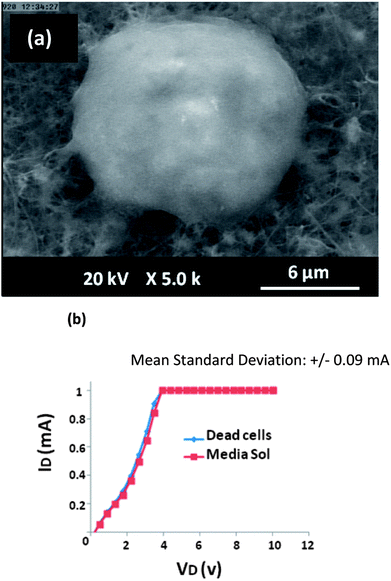 | ||
| Fig. 5 (a) SEM image of SW48 cancer cell on SiNW after 19 h without drug treatment. (b) Output characteristics of SiNW bioFET after covering by media solution and dead cells. | ||
4. Conclusion
We have demonstrated for the first time, a skein shaped SiNWFET with a nanowire covered gate surface fabricated using a low-cost method suitable for cell membrane electrical charge measurement. The membrane negative charges of different metastatic grades of colon cancer sensed by the device were different from each other. It is interesting to find that the surface negative charges of metastatic cancer cells membrane (SW48) caused lower drain current in comparison with primary cancerous ones (HT29). This exactly fit the predicted electric responses from p-type SiNW covered n-channeled FET device. Also, we used this device for a cancer EDR assay. Our results point to the SiNW bioFET which opens a new method for electrostatic charge based biosensing for future applications in biomedical diagnosis especially in cancer investigations.References
- D. R. Thevenot, K. Toth, R. A. Durst and G. S. Wilson, Biosens. Bioelectron., 2001, 16, 121 CrossRef CAS.
- D. Grieshaber, R. MacKenzie, J. Voros and E. Reimhult, Sensors, 2008, 8, 1400 CrossRef CAS.
- F. M. Raymo and I. Yildiz, Phys. Chem. Chem. Phys., 2007, 9, 2036 RSC.
- N. C. Tansil and Z. Q. Gao, Nano Today, 2006, 1, 28 CrossRef.
- A. M. Morales and C. M. Lieber, Science, 1998, 279, 208 CrossRef CAS.
- J. T. Hu, T. W. Odom and C. M. Lieber, Acc. Chem. Res., 1999, 32, 435 CrossRef CAS.
- X. F. Duan, Y. Huang, Y. Cui, J. F. Wang and C. M. Lieber, Nature, 2001, 409, 66 CrossRef CAS PubMed.
- X. G. Liang and S. Y. Chou, Nano Lett., 2008, 8, 1472 CrossRef CAS PubMed.
- M. Curreli, R. Zhang, F. N. Ishikawa, H. K. Chang, R. J. Cote, C. Zhou and M. E. Thompson, IEEE Trans. Nanotechnol., 2008, 7, 651 CrossRef.
- W. Wang, C. Chen, M. Qian and X. S. Zhao, Anal. Biochem., 2008, 373, 213–219 CrossRef CAS PubMed.
- M. Abdolahad, M. Janmaleki, M. Taghinejad, H. Taghinejad, F. Salehi and S. Mohajerzadeh, Nanoscale, 2013, 5, 3421 RSC.
- K.-I. Chen, B.-R. Li and Y.-T. Chen, Nano Today, 2011, 6, 131–154 CrossRef CAS PubMed.
- C.-Y. Hsiao, C.-H. Lin, C.-H. Hung, C.-J. Su, Y.-R. Lo and C.-C. Lee, Biosens. Bioelectron., 2009, 24, 1223–1229 CrossRef CAS PubMed.
- O. Hirotsugu, M. Kazuma, H. Kenichi, O. Toshinobu, H. Masahiko and N. Masayoshi, Jpn. J. Appl. Phys., 2007, 46, 4693–4697 CrossRef.
- D. K. Nagesha, M. A. Whitehead and J. L. Coffer, Adv. Mater., 2005, 17(7), 921–924 CrossRef CAS.
- K. C. Popat, R. H. Daniels, R. S. Dubrow, V. Hardev and T. A. Desai, J. Orthop. Res., 2006, 24(4), 619–627 CrossRef CAS PubMed.
- A. Poghossian, S. Ingebrandt, M. H. Abouzar and M. J. Schoning, Appl. Phys. A: Mater. Sci. Process., 2007, 87, 517 CrossRef CAS.
- J.-H. Ahn, S.-J. Choi, J.-W. Han, T. J. Park, S. Y. Lee and Y.-K. Choi, Nano Lett., 2010, 10(8), 2934–2938 CrossRef CAS PubMed.
- R. Elnathan, M. Kwiat, A. Pevzner, Y. Engel, L. Burstein, A. Khatchtourints and A. Lichtenstein, Nano Lett., 2012, 12(10), 5245–5254 CrossRef CAS PubMed.
- F. Patolsky, G. F. Zheng and C. M. Lieber, Nanomedicine, 2006, 1, 51 CrossRef CAS PubMed.
- I. Y. Park, Z. Y. Li, X. M. Li, A. P. Pisano and R. S. Williams, Biosens. Bioelectron., 2007, 22, 2065 CrossRef CAS PubMed.
- F. Patolsky, G. F. Zheng and C. M. Lieber, Nat. Protoc., 2006, 1, 1711 CrossRef CAS PubMed.
- M. V. Berridge, P. M. Herst and A. S. Tan, Tetrazolium dyes as tools in cell biology: new insights into their cellular reduction, Biotechnol. Annu. Rev., 2005, 11, 127–152 CAS.
- W. Kern, Handbook of semiconductor wafer cleaning technology, Noyes Publications, NJ, 1993 Search PubMed.
- H. Taghinejad, M. Taghinejad, M. Abdolahad, A. Saeidi and S. Mohajerzadeh, Sens. Actuators, B, 2013, 176, 413–419 CrossRef CAS PubMed.
- B. Alberts, A. Johnson, J. Lewis, M. Raff and K. Roberts, Molecular biology of the cell, ed. P. Walter, Garland Science Taylor & Francis Group, 5th edn, 2008 Search PubMed.
- R. A. B. Devine, Structural nature of the Si/SiO2 interface through infrared spectroscopy, Appl. Phys. Lett., 1996, 68, 3108–3110 CrossRef CAS PubMed.
- K. S. Midwood, M. D. Carolus, M. P. Danahy, J. E. Schwarzbauer and J. Schwartz, Langmuir, 2004, 20, 5501–5505 CrossRef CAS.
- H. F. Acevedo, Human chorionic gonadotropin (hCG), the hormone of life and death: a review, J. Exp. Ther. Oncol., 2002, 2(3), 133–145 CrossRef CAS.
- H. F. Acevedo, J. Y. Tong and R. J. Hartsock, Human chorionic gonadotropin-beta subunit gene expression in cultured human fetal and cancer cells of different types and origins, Cancer, 1995, 76(8), 1467–1475 CrossRef CAS.
- G. Kristine, E. G. Sandra, S. Meiyappan, P. P. Arvind, I. Yoshitaka and M. B. Zaver, Extracellular Acidification Alters Lysosomal Trafficking in Human Breast Cancer Cells, Neoplasia, 2003, 5(6), 533–545 Search PubMed.
- G. G. Steel, Growth Kinetics of Tumours, Clarendon Press, Oxford, 1977 Search PubMed.
- S. Ning, Y. Song and L. Wang, Electrical Characters on Surface of Apoptotic Cell in Maize Roots Induced by Cytotoxins, Dev. Reprod. Biol., 2000, 9, 65–72 Search PubMed.
- M. Taghinejad, H. Taghinejad, M. Abdolahad and S. Mohajerzadeh, A Nickel–Gold Bilayer Catalyst Engineering Technique for Self-Assembled Growth of Highly Ordered Silicon Nanotubes (SiNT), Nano Lett., 2013, 13, 889–897 CrossRef CAS PubMed.
Footnotes |
| † Electronic supplementary information (ESI) available. See DOI: 10.1039/c3ra46272b |
| ‡ These authors contributed equally to the work. |
| This journal is © The Royal Society of Chemistry 2014 |

